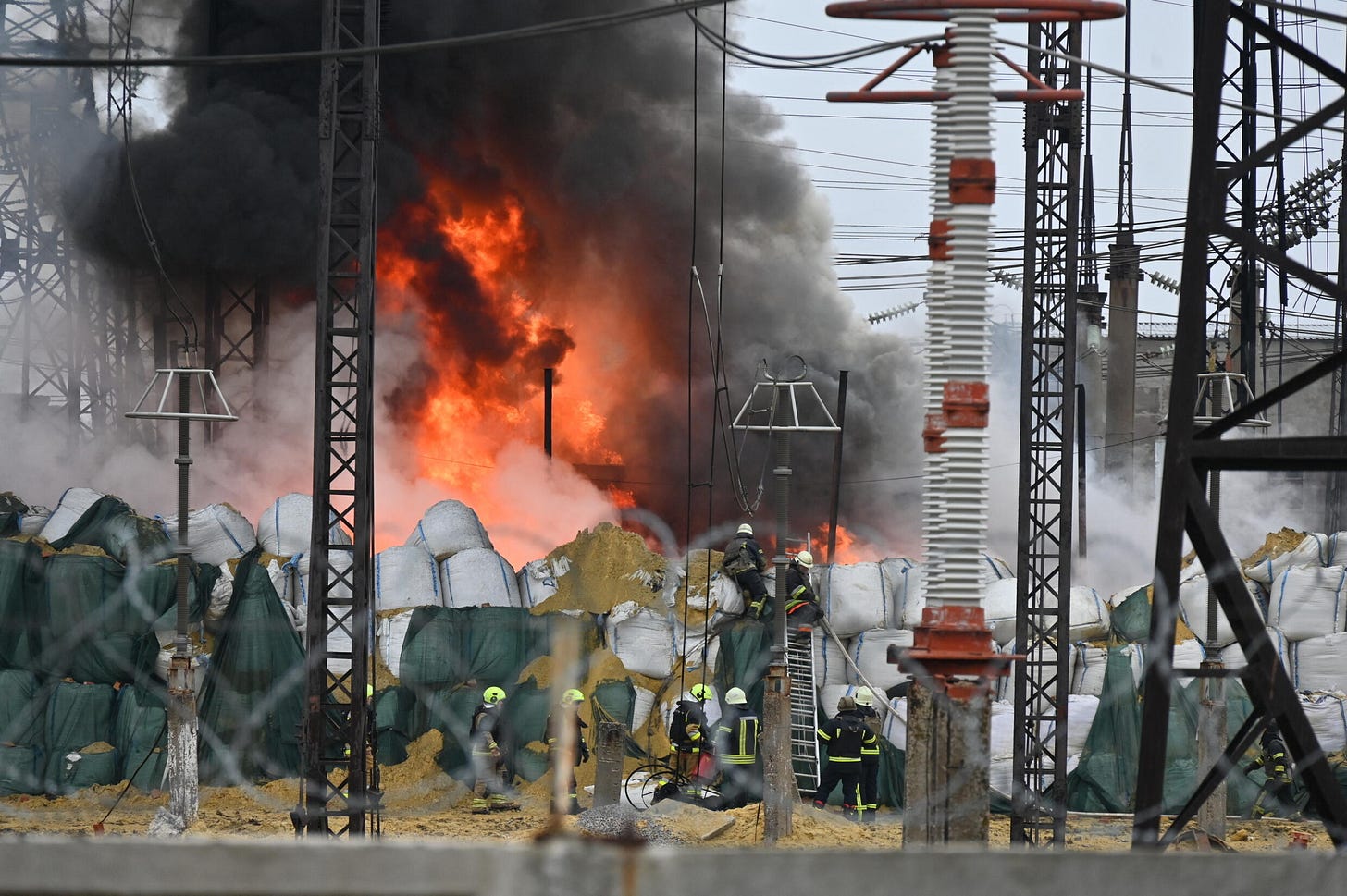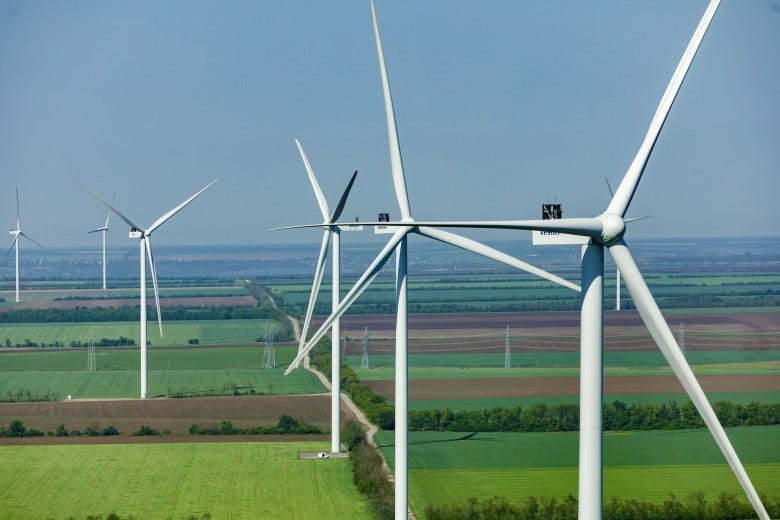Ukraine: Greening the Wartime Grid
Ukraine has chosen a renewable pathway to energy system restoration, as we hear from Roman Nitsovych, Research Director at DiXi Group.
Welcome to Netting Zeros, a podcast and Substack community that spotlights sustainability professionals, the challenges they face, and the opportunities they present. We are a small team with limited resources, so if you are enjoying what we are doing and want to see us grow, please subscribe and share this Substack, or – better still – pledge your support!
In this episode, we are delighted to speak with Roman Nitsovych is Research Director at DiXi Group, a Ukrainian think-tank focused on promotion of European integration, market reforms and higher transparency of the Ukrainian energy sector. A former activist and journalist, as well as editor of Ukraine Energy, Roman is a powerhouse advocate for Ukraine’s green transition and energy independence.
🎧Listen to Netting Zeros 🎧

DiXi Group was instrumental in putting forward Ukraine’s National Climate Energy Plan (NCEP), which cabinet ministers approved June 25, the same day as Ukraine formally began EU accession talks.
The NCEP, which covers the period up to 2030, aims to harmonise environmental, energy and economic policies for the sustainable development of Ukraine, while bringing its energy sector into line with the EU community. The main goals of the NECP include the following:
reducing greenhouse gas emissions by 65% compared to 1990 levels;
reaching a 27% share of renewable energy sources in total final energy consumption;
deepening the diversification of energy sources and supply routes - no more than 30% from a single supplier;
primary energy consumption not exceeding 72.224 million tonnes of oil equivalent (mtoe), final energy consumption 42.168 mtoe.
The world’s toughest green energy transition
Prior to Vladimir Putin’s full-scale invasion, nuclear served almost 60% of Ukraine’s electricity while fossil fuels provided around 25%, with solar (~5%), wind (~1%) and hydro combined accounting for the remaining 15% or so.
The NCEP is thus the first step on the path to what would be the world’s most difficult and remarkable green transition. It matches Ukraine’s commitment to its 2030 nationally determined contributions, submitted before Russia’s full-scale invasion, to reduce GHG emissions by 65% in 2030 compared to 1990 levels.
As Roman makes clear, long-term Ukraine is aiming for a fully decarbonised energy system with a roughly 50-50 balance between nuclear and renewables. He acknowledges that new natural gas power plants – turbine installation for which takes months rather than years – will likely be required to keep the lights on in the interim, but should later be converted to take Ukraine’s abundant supplies of bio-methane.
Thankfully, Ukraine has huge renewable potential, with the Institute of Renewable Energy of the National Academy of Sciences of Ukraine estimating the country’s total technical potential for renewable energy at 874GW.
A fascinating piece by Social Europe, a European digital media publisher and social democratic think tank, outlines how Ukraine faced two starkly contrasting scenarios when planning the restoration of its energy system. The decarbonisation pathway it has chosen, favoured by the European Green Deal, is reported to cost just 5% more than a return to fossil fuel dependence, but Kyiv’s rejection of the fossil fuel route is remarkable nonetheless.
“The task now is to ensure that we have enough backup power capacities for the critical infrastructure here: district heating utilities, water supply, water drainage, schools, kindergartens, hospitals, all those things which are really a matter of life and death, especially in winter.”
It is all the more astonishing given the pre-war trajectory, which could have seen Naftogaz, Ukraine’s state gas company, developing hugely significant hydrocarbon reserves around the Black Sea, a desire for control of which was one of several motivations for Vladimir Putin’s 2022 full-scale invasion.
Moreover, several key renewable assets have been seized or destroyed by Russian forces, including 300+MW of MW of wind and solar PV capacity in occupied Crimea, and the Kakhovka hydroelectric power station disaster of June 2023. And of course, the Zaporizhzhia Nuclear Power Plant (ZNPP) remains in Russian hands and continues to be a source of anxiety given its position on the frontline of the conflict zone. The nuclear energy agency keeps an up to date blog detailing the status of all Ukraine’s nuclear plants here.
Drone footage showing the extent of the devastation in the aftermath of the Kakhovka hydroelectric power station explosion. Source: The Guardian.
Kakhovka was a startling act of environmental terrorism. Russian forces exploded the dam, despite having captured the asset in the first days of the invasion and the consequent floodwaters largely engulfing their own side of the frontline. Its destruction will have economic, environmental and humanitarian repercussions for generations to come, while some flooded ecosystems and natural habitats may never recover.
As we hear, Roman maintains the perpetrators did not attract a sufficient degree of international condemnation or punishment – a sad affirmation of how waves of Kremlin disinformation aimed at sowing doubt as to who was to blame can “wash away the truth”. The terrible environmental impact is emblematic of a conflict that has so far generated at least 175m tonnes of carbon dioxide equivalent (tCO2e) – equivalent to putting 90m new petrol cars on the road, according to the Initiative on Greenhouse Gas Accounting of War (IGGAW).
Air defence and in-kind donations
Like many in Ukraine, Roman has been forced to add “defence expert” to his multiple professional hats in order to fulfill his basic job function, and he echoes President Zelensky and others in calling for the urgent delivery of more weapons and air defence systems.
Roman traces how the Kremlin has systematically unpicked Ukraine’s energy system in a bid to make the country unlivable, a cynical ploy to depopulate and demoralise. He shares how Putin’s forces switched their focus from targeting power grid substations to attacks on flexible base load power providing coal and hydro power plants.
“The number one message is, deal not with the consequences, but with the root cause. The sooner we force Russia to end the war and to withdraw its troops from our sovereign territory, the better it would be for everyone.”
Without sufficient air defence armaments for active defence, and greater investment in “passive” defence against drones, missiles and related shrapnel, including reinforced concrete domes to protect the substations (think Chernobyl-style encasements), any thought of a green transition is of course meaningless.
Roman also appeals for in-kind donations from you, in that SMEs can supply the generators, solar PV inverters, home batteries, and other vital equipment that Ukraine needs to keep the lights on this winter. Get in touch with us if you want to know more about how to get vital aid to Ukraine.

Funding energy system restoration
When we spoke, Roman was gearing up for the Ukraine Recovery Conference in Berlin, which delivered an €15m ($16m) grant from Germany’s state-owned development bank KfW to restore substations damaged by Russia’s early attacks.
Naftogaz, meanwhile, secured a Technical Assistance Grant from the European Investment Bank to develop a Decarbonisation Strategy, while the World Bank pledged $47m under the Restoration Project of Winterization and Energy Resources (Re-PoWER Ukraine), which aims to restore basic services to the energy sector of Ukraine.
Several renewable energy deals for the supply of gas turbine and gas piston units were also signed, and the U.S. was reported to have committed to an $824m energy support package. A full list of the investments, grants and other financial aid signed off at the conference is available here.
Overall, the NCEP will require up to $50bn to implement, much of which will be channelled through the independent Ukraine Energy Support Fund, which acts as a secure and trustworthy funnel for international donations. But as Roman makes clear, Ukraine is also open for private sector investment across its energy sector.
Despite the litany of challenges he details on the tape, Roman feels more can be done to communicate the scale of the energy opportunity in Ukraine. Indeed, the country has made significant strides in removing red tape around the deployment of decentralised renewable power. Ukraine is already installing onshore wind at a steady clip, having commissioned the 114 MW Phase 1 DTEK Tyligulska Wind Power Plant in May 2023, and is now ready to embark on the 384 MW Phase 2. The UK, by contrast, managed to install 0 MW in the same period since the full-scale invasion.

Recovering Ukraine
Whether Ukraine’s green transition would be happening without Roman and DiXi Group’s efforts is uncertain, but it is not inconceivable that without such vocal advocates Ukraine may have chosen a different path to energy system recovery. After all, who would begrudge a nation that has suffered so much, choosing what is too often billed as the “easier” path?
The path Ukraine has chosen will be long and arduous but could potentially result in a blueprint that demonstrates that talk of the green transition being “too costly” or “difficult” is frankly bullshit. If Ukraine pulls this off, those excuses simply will not wash. In the meantime, Ukraine requires generators, gas turbines, solar inverters, home batteries and a myriad other bits of equipment necessary to keep the lights on this winter.
“Generators of all kinds and sizes are needed to power up our schools, kindergartens, administrative offices, public authorities, social care institutions, district heating, water supply and sewerage utilities, and to allow us to pass through winter in the cities.”
If you have access to any of the equipment Roman calls for in this episode and can see a way to parting with it over a matter of life or death, you know what to do.




